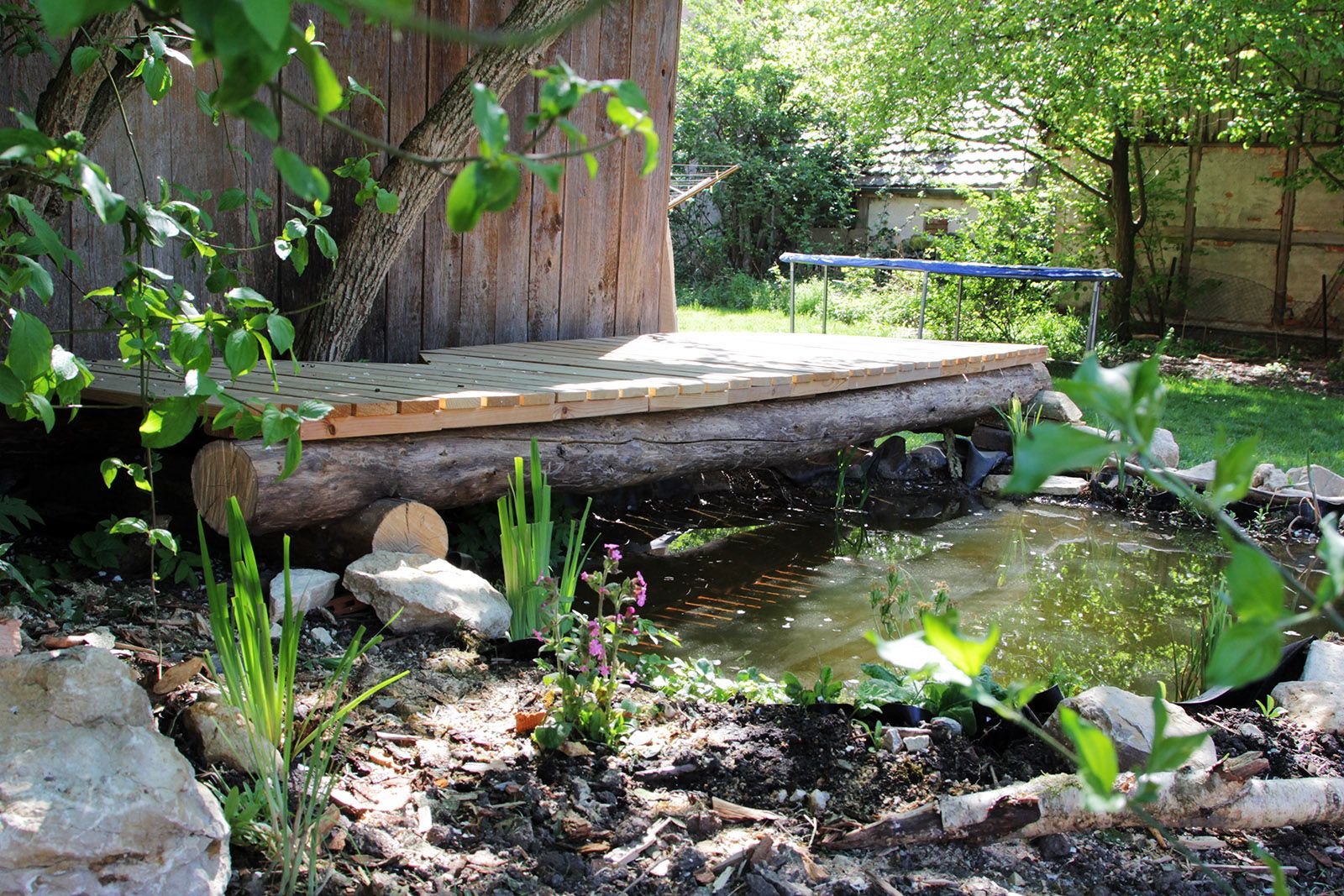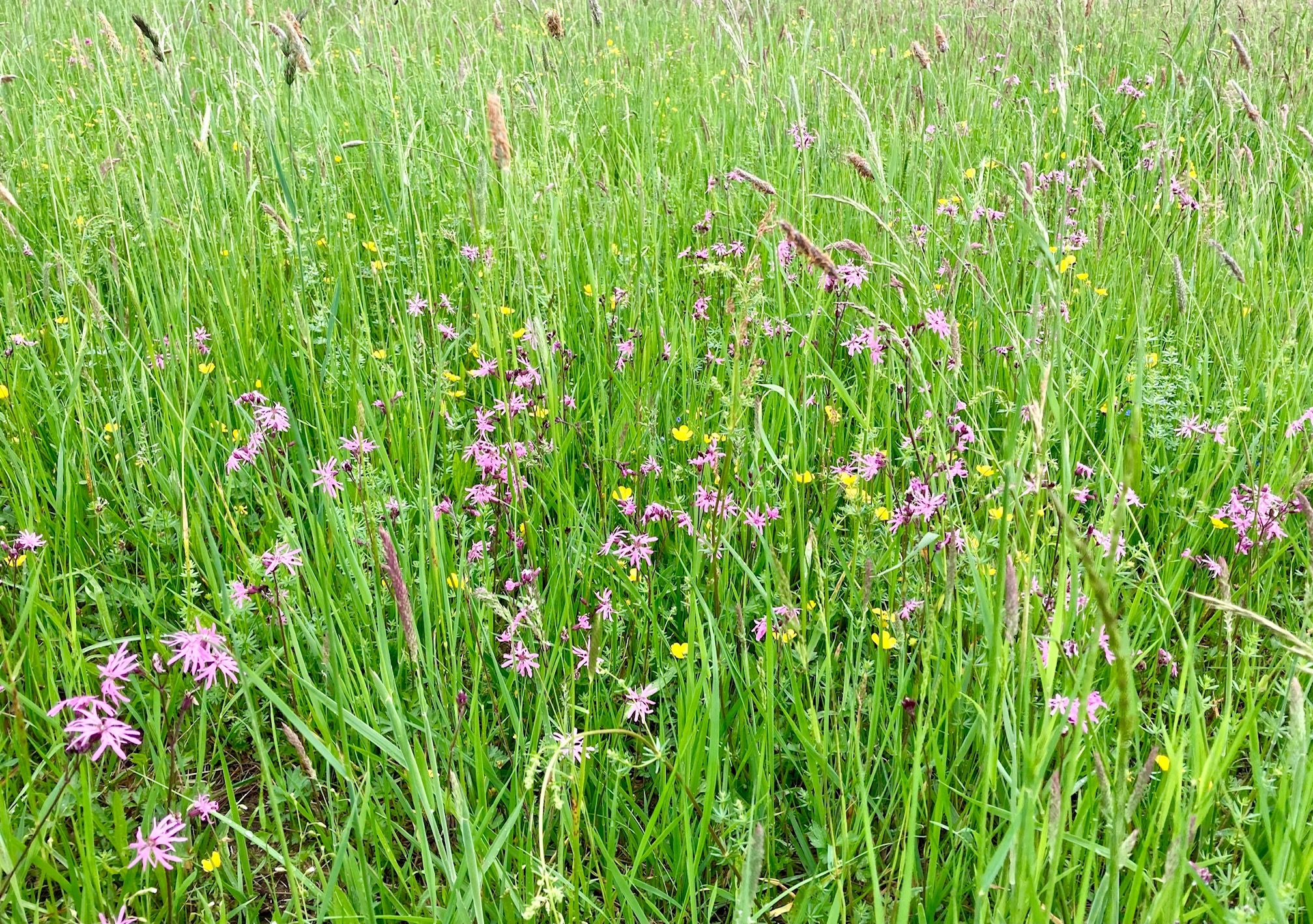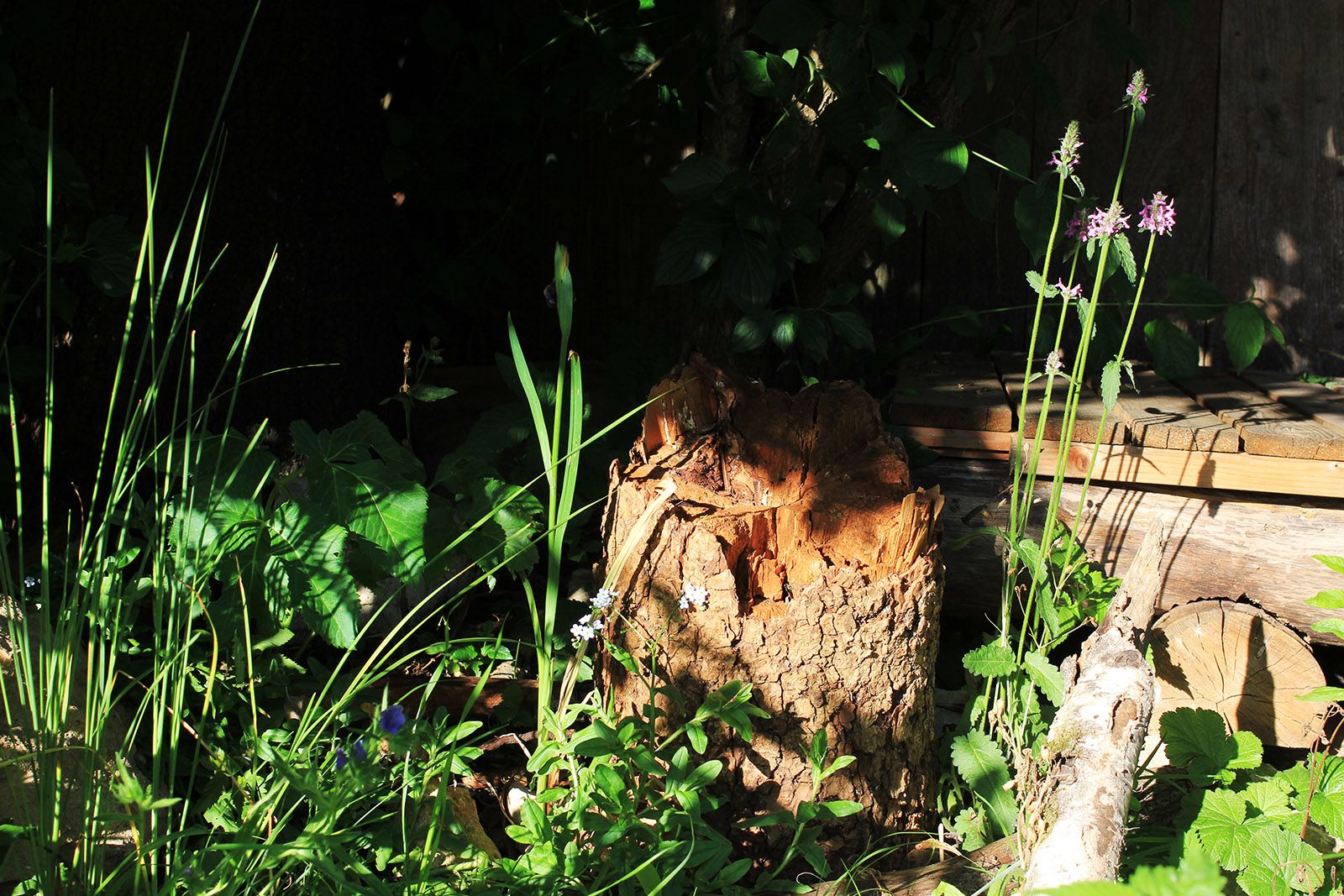Creating a swamp bed
If you want to create a wetland in your garden, or even just a small wetland/swamp bed, first take a good look around. Maybe there is already a natural depression where rainwater collects and runs away. Or you already have a pond in the garden, in whose edge area (see picture below) a marshy bed fits perfectly of course. However, it should not be in direct connection with the pond, otherwise nutrients will diffuse into the pond over time, and the algae will be happy.
Now you just have to make sure that the water in this area does not seep into the ground so quickly. You can do this in the same way as when building a pond. Either you seal with clay or loam, i.e. natural materials, or you use an EPDM pond liner for this purpose. For ecological reasons, do not use PVC foil if possible. If the soil is heavily interspersed with stones, it is advisable to install a protective fleece between the substrate and the liner.
Remove vegetation
The first step is to dig down the existing vegetation and excavate a trough. A depth of 30 cm is sufficient. Possibly use a spirit level to avoid larger differences in height. The excavated pit can then be used again as a planting substrate; the usually nutrient-rich, rather loamy garden soil is well suited for most of these wetland plants. The trough is then sealed with clay, loam or foil in the next step. Dig the liner in a bit at the edges and see that the soil in the bed does not have a direct connection to the soil outside. Otherwise, there will be an osmotic suction effect from wet to dry. Therefore, at the transition, set up a capillary barrier with mineral material..
Then, fill the trough with the excavated pit, collect the earthworms that appear, and relocate them to other garden areas (without film). Now you can also put stepping stones, which will be clever later, if you want to reach all areas dry, or, which is also very nice, plan a small walkway of wooden planks above. Once the wetland is flooded, wait a few more days for the soil to settle a bit before planting.
By the way, water fluctuations of a few centimeters are very well tolerated by these wetland plants, in real natural locations it is no different. Only completely dry out the bed should not.

Planting or sowing
The meadowsweet (Filipendula ulmaria, cover picture) could play a prominent role here, for example. Our ancestors already knew what they had in meadowsweet - they scattered it around the house to perfume the house with the sweet honey scent (nomen est omen). Honey wine was flavored with it, and apparently, brewed as tea, it also helped the next day if you got too much of it. Surely this has to do with the salicylic acid it contains; meadowsweet is actually a precursor to our aspirin. You can also use the super herb for smoking. The flower panicles, picked around the summer solstice, are said to help us let go of the old and boldly embrace the new.The animal inhabitants in our garden also like meadowsweet. Honey bees, wild bees, bumblebees, beetles, pollen-eating flies can always be found on the small flowers, because the pollen is easy to get. In addition, 16 species of different butterfly caterpillars still feed on the leaves. All in all, a convincing plant.
It's matched by wood angelica (Angelica sylvestris), which is also an excellent wild bee forage plant. Its seeds are fall and winter food for birds.

Water Wort, Meadow Knotweed, Greater Meadow Buttercup, True Soapwort, Cuckoo's Campion, Marsh Cranesbill, Valerian, Brook Clovewort, or the Devil's Abbiss.... there are plenty of wild perennials that love such fresh, moist, rather nutrient-rich sites. Use the chart at the end of this post as a guide when planning plantings.

Or plant with a suitable seed mixture from one of the listed wild plant seed producers (e.g. Rieger-Hofmann, Syringa, Lebensinseln (here you can also get smaller quantities of autochthonous, i.e. native, seeds).
What animals benefit from our wetlands?
Wetlands always have a high diversity of species. Compared to the patch of lawn we converted, we are definitely enriching our garden a lot.We can't attract all the highly specialized caterpillar and butterfly species with this small area - but we will definitely get visits from numerous butterflies, wild bees, grasshoppers, beetles, wasps and dragonflies. In addition, amphibians such as frogs and toads use wetlands as temporary habitats; they also, of course, need standing water areas in which to spawn and where their offspring, the tadpoles, can develop. Dragonflies also need bodies of water to rear their larvae.

So it is ideal if we combine different biotope elements in our garden. 'Messy' hiding places made of old roof tiles, piles of dead wood, leaves, wild shrub hedges - the more naturalistic structural elements we create in our garden, the more interesting it will be for the animals and the more adventurous for ourselves.
Suitable mowing times, if it has become more of a wet meadow, are mid-June and mid-September as a guide. In true marsh beds, you really don't have to plan for much maintenance, except for pruning the perennials in the spring, so it's just like other perennial beds.
Unlike the pond, leaf fall on the bed in the fall is not a problem. On the contrary, here the nutrients are desired, and besides, the foliage cover protects against the great winter cold.

Tall herbaceous meadow on freshly moist, nutrient-rich soils:
- Brook Clarywort (Geum rivale).
- Valerian (Valeriana officinalis)
- Comfrey (Symphytum officinale)
- Purple loosestrife (Lythrum salicaria)
- Angelica archangelica (Angelica archangelica)
- True soapwort (Saponaria officinalis)
- Marshmallow (Althaea officinalis))
- Common burnet (Prunella vulgaris)
- Common yarrow (A. millefolium)
- Devil's-bit (Succisa pratensis)
- Big burnet (Pimpinella major)
- Greater meadow buttercup (Sanguisorba off.)
- Medicinal Creeping Chicory (Stachys off./ Betonica officinalis)
- Cuckoo's campion (Lychnis flos-cuculi)
- Meadowsweet (Filipendula ulmaria)
- Pennywort (Lysimachia nummularia)
- Red campion (Silene dioica)
- Lesser Celandine (Ranunculus ficaria)
- Sharp buttercup (Ranunculus acris)
- Ostrich loosestrife (Lysimachia thyrsiflora)
- Marsh marigold (Caltha palustris)
- Marsh yarrow (Achillea ptarmica)
- Marsh cranesbill (Geranium palustris)
- Marsh Forget-me-not (Myosotis palustris)
- Marsh Creeping Chicory (Stachys palustris)
- Troll flower (Trollius europaeus)
- Forest angelica (Angelica sylvestris)
- Water Wort (Eupatorium cannabinum)
- Willowherb species (Epilobium spec.)
- Meadow knapweed (Centaurea jacea)
- Meadow ragwort (Galium mollugo)
- Meadow daisy (Leucanthemum vulgaris)
- Meadow pippa (Crepis biennis)
- Meadow vetchling (Lathyrus pratensis)
- Meadow foamwort (Cardamine pratensis)
Grass selection wet meadow:
- Blue Pipegrass (Molinia caerulea)
- Fluttering rush (Juncus effusus)
- Common crested wheatgrass (Cynosurus cristatus)
- Common bentgrass (Anthoxantum odoratum)
- Golden oat (Trisetum flavescens)
- Rabbit's foot sedge (Carex leporina)
- Marsh cordgrass (Poa palustris)
- Meadow bluegrass (Poa pratensis)
- Meadow fescue (Festuca pratensis)
- Woolly honeygrass (Holcus lanatus)
Cover photo: meadowsweet (Filipendula ulmaria)
Useful addresses
www.naturgarten.orgwww.tausende-gaerten.de
www.hortus-netzwerk.de
Sources of supply
www.gaissmayer.dewww.gaertnerei-strickler.de
www.rieger-hofmann.de
www.lebensinseln-shop.de
www.hof-berggarten.de
www.syringa-pflanzen.de






